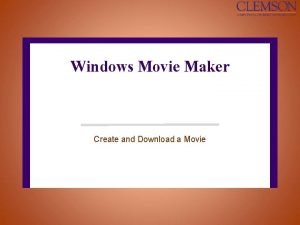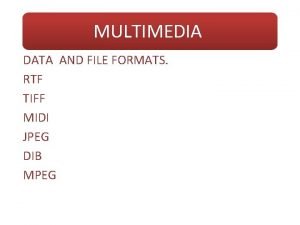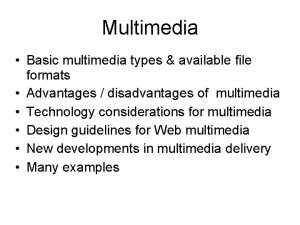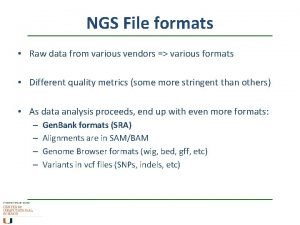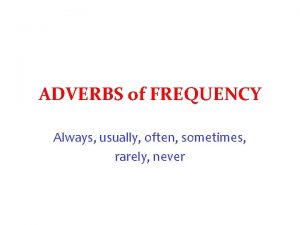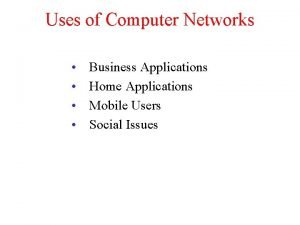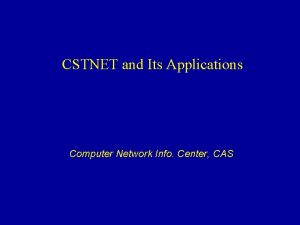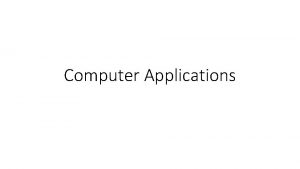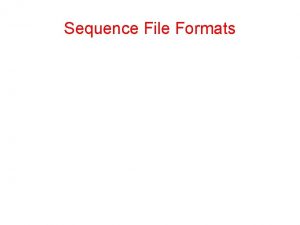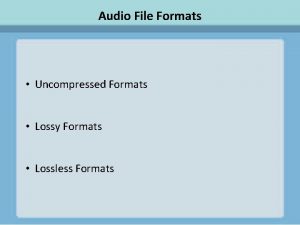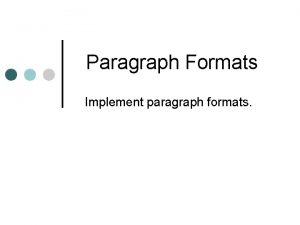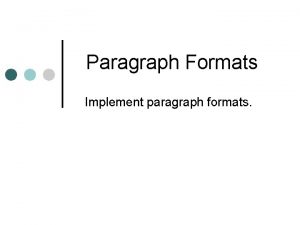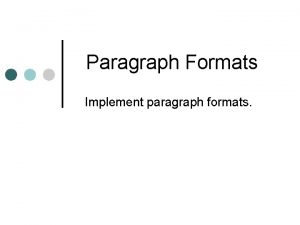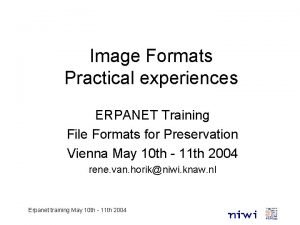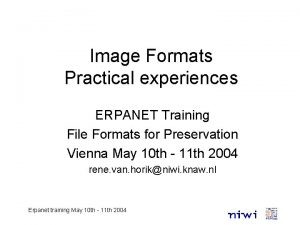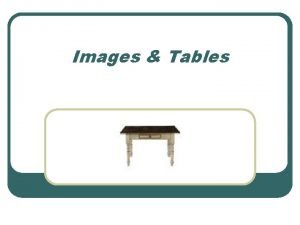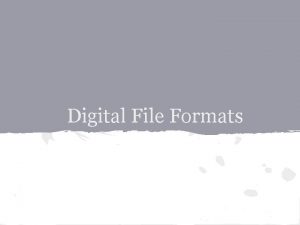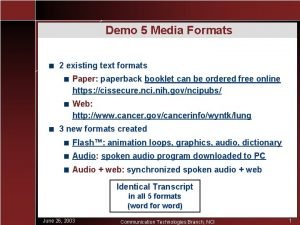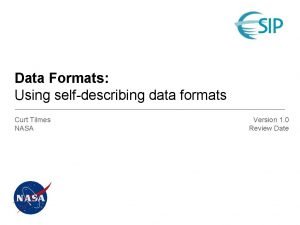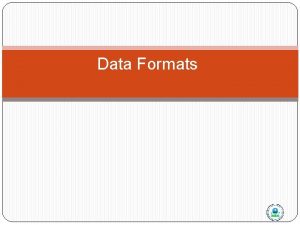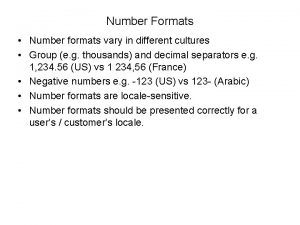Computer Applications File formats File formats are often
























- Slides: 24

Computer Applications

File formats • File formats are often ignored by users • Applications automatically save files in the application’s format • All formats are made for a reason, efficiency, effectiveness – saving the information needed to recreate the document as saved • Many formats are commercial, they add to the creating company’s bottom line by keeping customers locked into the company’s software

Windows Registry (New) • When a new application is installed on a machine with Windows OS, it usually adds itself to the Registry • The Registry is a file kept in the Windows file system which records which application is associated with which file extensions (among other things) • This allows you to double-click on an icon representing a document of some kind and Windows knows which application to use to open it • Can be a battle between applications sometimes about which one “gets” an extension • Viruses are also known to store themselves in there to hide from anti-virus software. • Be VERY careful if you edit the Registry!

Digital Rights Management • DRM - added to some formats • Prevents files from being copied or from being played on unauthorized devices • AAC (extension. m 4 p) has DRM from Apple • Subject of much controversy

Audio player apps • Sound is Analog - to manipulate it with a computer, it must be converted to digital • Microphone takes in analog sound waves and the audio app samples the signal every so often (44, 100 samples per second is common) • Each sample is turned into a number using an Analog-to-digital converter • Sound is played back by putting the numbers through a Digital-to-Analog converter and out through a speaker • Most OS’s come with an app for playing music/sound • To edit sound you usually need to find either a shareware or commercial application

ADC and DAC sound processing

Audio file formats • Most popular format MP 3 • Compressed by cutting off the “high” and “low” parts of the original recording, under the assumption that most humans can’t hear them – not as good as the quality of a CD • Good enough – small enough for fast downloads, but “lossy” • Most CD rippers create MP 3’s

Other audio formats • WAV (Windows audio-visual file) (uncompressed) • AIFF (Audio Interchange File Format) (Apple) • These are popular with professional musicians • Better quality than MP 3’s, “lossless” • Not compressed, so large files (10 MB for one minute of stereo audio) • (New) MIDI (Musical Instrument Digital Interface) – a standard for capturing sound from different instruments and storing it – you can buy instruments (guitar, drums, keyboard, etc. ) which have a MIDI port. Mostly used by professionals

Video player apps • Video is a file that contains many slightly differing images which are displayed quickly enough that human eye/brain cannot see them as individual. So they look like continuous motion to us. Each image is called a frame and the speed they are displayed at is the frames per second (fps) • Video files are very large. Most formats like mp 4 or mov use some form of compression. They do not store every single image fully. They will store certain frames (called key frames) completely, then store only the information about how the other frames differ from the key frames

Video Formats • AVI – oldest, lots of apps can play them, not as good a quality as newer formats • WMV – From Microsoft, not good quality, small size file • MOV – Apple Quick. Time – high compression, decent quality • MP 4 – newer format, high compression, decent quality, can be played by most browsers

Video Player Apps • Quick. Time for Macs • Windows Media Player on Windows • Free VLC • Streaming – playing video directly from the Internet using an app like a browser without storing the data on secondary storage – comes into RAM and is played as quickly as possible

PDF viewer • Portable Document Format • Created by Adobe, released to public in 2008 • Readable/viewable by almost any application that creates documents under many different OS’s • Easy to create / edit these days – many apps have option to “Print to PDF”

Text formats • Even with composing email, you are creating text in a format of your choosing • When you write a message in a proprietary format like docx and send it as an attachment, the recipient has to double click the link, which downloads the file, opens Word, lets them read the message, then go back to the email client • Compare the size of a text file to a Word docx file which contains the same words. The difference can be huge! Why? Word stores many hidden ‘control characters’ as well as more information about the file – the author, the font used, large chunks of text that were deleted…

In the old days • Cameras were “analog” – film-based • Photos were expensive to make • You did not make duplicates • Prints had to be treated very carefully, negatives even more so! • Photos took a long time to make, usually by mail

Today • Cameras are digital – recording light frequencies as numbers on a storage medium • Cameras rated as “so many Megapixels” resolution • Photos are cheap, good quality and immediate • Now you can take lots of pictures of the same scene, and discard the bad / poor quality ones • Information overload – too many pictures!

Storing / Organizing Photos • “Metadata” • • You can rate photos with “star ratings” Put keywords or tags on them Have to keep using the system or it is useless If you are using a particular application / site to store your metadata, you are bound to it

Cautions about photos • Don’t put photos on the net (or on a phone) which you do not want seen by EVERYBODY • Don’t expect you can “erase” a photo once it is on the Net or sent to someone else – “bits are forever” – backups always exist somewhere • Be aware that many photos have “hidden information” which can be read pretty easily – GPS coordinates, IP number, type of camera, time and date

Maximize the bits then Filter! • Take lots of pictures – the bits are free • This increases the chances that one will be worth keeping • Try different angles, flash or not flash • Instead of a tag, erase most of the photos and keep only the best • Erase the fuzzy, the out-of-focus, the good-but-duplicates • What you have left makes you look like a great photographer!

Picture formats • Different picture formats are for different purposes • Most common is probably JPG or JPEG – joint photographic experts group • Designed to work with pictures with many different colors and shades of color (over 16 million colors) • JPG compresses information whenever possible • Best for photographic images

GIF and PNG • JPG not good for simple images with clear edges and not too many colors • GIF was created by a company called Compuserve a long time ago for use on their on-line system (even before AOL!) “Graphics Interchange Format” • Good for images with relatively few colors (up to 256 colors) • Designed to be as small as possible • Can have some animation in the file • Can be created by MS Paint or Gif editors

GIF and PNG • Compuserve in its last days began to be possessive of its format – insisting on being paid by anyone else writing software to view or manipulate GIF files • PNG was created in reaction to this action • “Portable Network Graphics” was declared to be free and open to anyone who wanted to use the format • More colors than a GIF but no animation

Lossless vs. Lossy Compression • All photo formats compress the data in the image to make the smallest possible file • JPG uses a “lossy” compression – details of the image can be lost if the user is willing to give them up in exchange for a smaller file • GIF and PNG use “lossless” compression methods – they reproduce the image data exactly – can give a larger file if there are lots of colors in the picture

Felis_silvestr is. jpg: Michael Gäbler Note how the quality of the jpeg encoding increases as you go from left to right. The left side has “artifacts” because quality is low. Low quality also implies smaller file sizes; higher quality leads to larger file sizes.

Troubleshooting • On any kind of electronics, it pays to know how to “reboot” or “reset” the equipment • Even under normal operations, after a period of time, an app can encounter a bug, even the OS may run into an error. • Turning the power completely OFF (not just “sleep mode”!) will sometimes help reset things back to a “known working state”. • If that does not happen, try some common sense things that you might predict would be wrong – see if they are – is it plugged in? is the power to the house on? Is it turned on? Is it connected to the other device? • If none of that helps, try getting more information “Google it!”
 Antigentest åre
Antigentest åre File-file yang dibuat oleh user pada jenis file di linux
File-file yang dibuat oleh user pada jenis file di linux Montaj maksud
Montaj maksud File formats in multimedia
File formats in multimedia File formats in multimedia
File formats in multimedia File formats in multimedia
File formats in multimedia Ngs file formats
Ngs file formats Hadoop file formats
Hadoop file formats Data formats in computer architecture
Data formats in computer architecture Data formats in computer architecture
Data formats in computer architecture Usually often rarely sometimes
Usually often rarely sometimes Uses of computer in business
Uses of computer in business Discrete math tutor
Discrete math tutor Mainframe computer vs supercomputer
Mainframe computer vs supercomputer Principles of network applications
Principles of network applications Objectives of computer applications
Objectives of computer applications Computer integrated manufacturing applications
Computer integrated manufacturing applications The elements of a computer
The elements of a computer Computer networks and internets with internet applications
Computer networks and internets with internet applications Business application in computer network
Business application in computer network Business applications of computer networks
Business applications of computer networks Cstnet
Cstnet Difference between logical file and physical file
Difference between logical file and physical file Fungsi sistem file
Fungsi sistem file Distributed file system
Distributed file system


